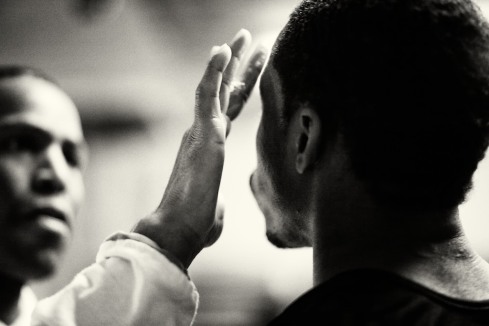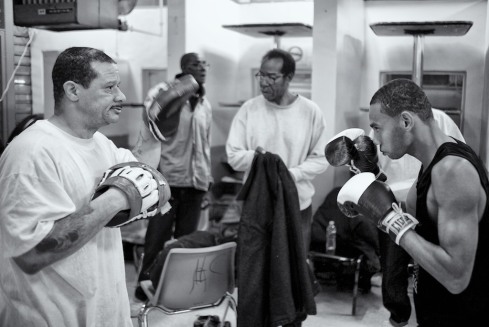
In the management of prisons, fighting is an activity prohibited by the authorities (bar some exceptional instances) and a sign that the regime and control measures are failing. However, at Louisiana State Penitentiary (commonly known as Angola), the Angola Amateur Boxing Association provides equipment and space for prisoners to spar and bout. From the Louisianan Dept. of Corrections website:
“The prison’s boxing program sponsors “fight night,” held every few months with boxing teams from other state prisons competing for corrections department championship belts. The Angola Amateur Boxing Association has held more belts in all weight classes through its 25-year history than any other prison boxing club in the state. The organization is a member of the Louisiana Institutional Boxing Association.”
In February of 2010, Baton-Rouge based photographer Frank McMains went to Louisiana State Penitentiary to document the club, the fighters and a bout. I asked him a few questions about the experience. [Underlining added by me]
How did you hear about the boxing club?
I had heard about prison boxing through another photographer who had attended a bout at a different prison in Louisiana. Oddly enough, he went without his camera. There is also a documentary about a volunteer boxing coach at Angola and I happen to know the guy who put that together. In short, among those who are interested in such things, boxing at Angola and intra-prison boxing between different prisons in Louisiana is somewhat widely known.
Did you do the story on assignment or of your own volition?
These shots were taken because of my interest in Angola and my interest in the boxing specifically. I pitched it to a few national magazines and one picked it up, but the folks at Angola were uncomfortable with the magazine that was interested in running the photos and article. They felt it was not a serious enough venue for the subject, so the photos remained un-published.


How did you gain access?
Angola is surprisingly accessible for a maximum security prison. I can’t say I have tried to get access to any others, but my sense is that they welcome outsiders who want to report on what is going on there. Over the course of several articles about different activities at Angola I have built a relationship with some of the wardens and staff. As a result, I didn’t really have to negotiate for access so much as plan around their schedule. Recent funding cutbacks meant that Angola’s boxing team did not fight teams from other prisons as they had in the past. There just wasn’t the money to transport the prisoners. So, the whole program was kind of in flux for a while, but once they confirmed a date, I wasn’t going to miss it. The staff at Angola are very professional and they are clear about what sort of interactions you can have with inmates as well as what sort of things you can bring into the prison. I have had my gear searched before but the prisoners who are allowed to participate in events like the rodeo or boxing matches are ones the prison administration feels are less of a threat. They basically would not let you into an area with prisoners who they didn’t trust and they also wouldn’t let someone into the prison with a bag full of gear with whom they didn’t feel comfortable.
How many individuals were involved?
There were about eight bouts so that means 16 boxers. However, there were about 150 prisoners who were there to watch the event and cheer on their friends. In the room with us there were probably four guards who sort of came and went as well as a few staff members and the warden with whom I was acquainted.




How did the prisoners talk about the AABA? Had it changed their behaviour or outlook?
One of my real regrets about this project is that I didn’t get a chance to talk to the boxers in more depth. As they were warming up for the fights they were focused on the what was ahead of them and I didn’t want to interfere with that. After the fights were over I spoke with several of the fighters and coaches but it was very informal.
It has been my experience that prisoners are much more interested in talking about where their family might see the photos and things that don’t pertain to their life in prison. Most of the conversations I had after shooting these photos were about people’s families, not about their lives behind bars.
I would like to follow up with the guys involved, but it was sort of outside of the scope of this shoot.
Some people might think boxing is not the right activity for prisoners; that it is violent. What would you say to people with these reservations?
Some people will always object to boxing as a brutal activity whether that is in prison or in Las Vegas. I get that objection, although I see it as graceful and pure in a way that many sports are not, but you can’t deny that it is violent. Last I checked that was a component of the human condition.
When it takes places in a prison I think it is understandable that some people would balk at what could be construed as violence piled on top of violence. It has been my experience that anything that the prisoners get to do is a step towards socializing them and giving them some hope in the face of a pretty bleak future. Angola has an unusual approach to punishment; they try to engage the prisoners in as many activities as possible. The prisoners work the land there to feed the prison population, they maintain the facilities and even staff the prison museum and gift shop. There is also a prisoner run newspaper and radio station. So, if you remove the fact that it is boxing from the equation then I think that an approach to incarceration that does something other than let people rot away in a cell is a good thing; boxing is a commitment to rehabilitation.
The other aspect of life at Angola is that most of the prisoners will die there, simply put. Most are serving life sentences without the possibility of parole. I understand the punishment-as-vengence argument that some might have. It is understandable to look at a murderer and say, “Who cares if they have any dignity.” I think the staff at Angola see a path for redemption for the prisoners that runs through many different courses. It might be boxing, it might be prison ministry. They seem to think that engaging the prisoners is preferable for all concerned to treating them as de-humanized creatures who simply have to be warehoused until the end of their days. From that perspective, Angola seems to run pretty well. Less than a quarter of the inmates are housed in cells and they spend their days working to make the prison run. That, to me, speaks for itself.




Did you get any sense of what the boxers wanted from you as a photographer? Did they want to convey any message to the eventual viewers?
Yes, every time I have photographed at Angola it is pretty clear that the prisoners want to be portrayed as retaining some of their human dignity. Beyond that, they long for connections with the outside world, their family in particular. You can’t forget that the prisoners at Angola have committed horrible crimes, but it is hard to not feel some sympathy for the incredible loneliness and isolation they all seem to share. Maybe they deserve that, it isn’t really for me to say what justice should look like.
How was, and how is Angola? What’s the culture like? How is it perceived?
All of my experiences at Angola have been unsettlingly mundane. In my mind, I expected to see prisoners rattling tin cups on metal bars and walking around in leg-irons or something. But, they are mowing the grass, cooking food, painting buildings, essentially participating in their own, highly-unusual little community. When people think about Angola, if they think about it outside of the rodeo, it seems that they imagine a dreary place of routine horror. I am sure that it is rough out there, very rough in many respects. But, it does not have the feeling of an armed camp where gangs are pitted against each other, where races are seething to tear into one another or where the guards are everywhere searching for escape tunnels. It’s culture will confound your expectations. Or, it did mine anyway. I didn’t grow up with any sense of prison life outside of film and television. If Angola is anything, it is unlike those scenes from popular entertainment. That is not to say it is bucolic or some penal Club Med. It is a sad but necessary place where the passage of time and the intrinsic nature of humanity do not conform to the normal rules.
It seems there have been many photographers who’ve shot at Angola (I might go so far to say it is the most media-present prison in America). Would you agree? What would one attribute that to?
In a word, yes. It is a thoroughly media documented prison. I think that is for two reasons. First, it is highly unusual in its approach to incarceration as I have spelled about above. They just do things differently there in terms of engaging prisoners rather than just warehousing them.
Secondly, it seems that the administration at Angola, starting with warden Burl Cain and running all the way down, are genuinely empathetic to the prisoners. They know that some of them have been changed, and perhaps redeemed, by the way Angola does things and they want people to know about it. I think they are also keenly aware of how the lack of hope not only destroys the human spirit but also makes prisoners much more difficult to handle. If the prisoners have a reason to get up in the morning then they see a value in toeing the redemptive line that Angola is pushing.
The staff know it is expensive and pointless to incarcerate grey-haired old men who are no longer a threat to society. It seems that Angola is trying to re-humanize prisoners in the eyes of the general public in an effort to change the way our legal system approaches punishment and justice.
Thanks Frank.
Thanks Pete.
_________________________________________________________
Frank McMains is a jack of many trades. He’s got a lot of Flickr. I thank Frank for his time to share his work and thoughts. You can read more about Frank’s time photographing at Angola at his own website Lemons and Beans.



5 comments
Comments feed for this article
August 11, 2011 at 11:51 am
D.Schwab
Great photos!
August 11, 2011 at 6:46 pm
Tripp Cox (@babybabygrand)
Great article and as always with Mr. McMains, spectacular photographs!
March 9, 2015 at 1:39 pm
“They Didn’t Want Us To Show the Reality, the Gore”: A Chat with Photojournalist Giles Clarke | Prison Photography
[…] Richardson, Tim McKukla, Sarah Stolfa, Adam Shemper, Lori Waselchuk, Deborah Luster, Serge Levy, Frank McMains and thousands more. Even I’ve had a […]
March 13, 2018 at 6:38 am
Dao
You are completely mistaken on gray haired old men not being dangerous. Age has only increased the cunning of their predatory instincts. The statistics bear me out. You should have had a shot of the entire team, trainers and coaches. Another shot of the champs.
June 5, 2019 at 4:44 am
Henry Montgomery Paved the Way for Other Juvenile Lifers to Go Free. Now 72, He May Never Get the Same Chance. – Freedom's Back
[…] for educational programming, Montgomery founded the Angola Amateur Boxing Association, which still exists today. “We all learned the discipline, not only for self-protection, but to deal with the […]